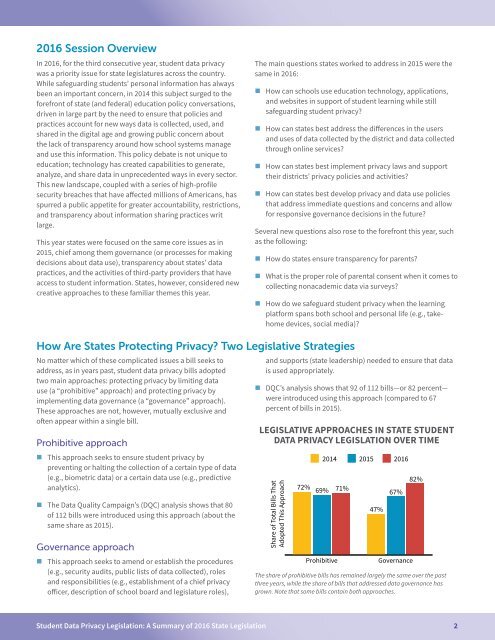Student Data Privacy Legislation
DQC-Legislative-summary-09302016
DQC-Legislative-summary-09302016
Create successful ePaper yourself
Turn your PDF publications into a flip-book with our unique Google optimized e-Paper software.
2016 Session Overview<br />
In 2016, for the third consecutive year, student data privacy<br />
was a priority issue for state legislatures across the country.<br />
While safeguarding students’ personal information has always<br />
been an important concern, in 2014 this subject surged to the<br />
forefront of state (and federal) education policy conversations,<br />
driven in large part by the need to ensure that policies and<br />
practices account for new ways data is collected, used, and<br />
shared in the digital age and growing public concern about<br />
the lack of transparency around how school systems manage<br />
and use this information. This policy debate is not unique to<br />
education; technology has created capabilities to generate,<br />
analyze, and share data in unprecedented ways in every sector.<br />
This new landscape, coupled with a series of high-profile<br />
security breaches that have affected millions of Americans, has<br />
spurred a public appetite for greater accountability, restrictions,<br />
and transparency about information sharing practices writ<br />
large.<br />
This year states were focused on the same core issues as in<br />
2015, chief among them governance (or processes for making<br />
decisions about data use), transparency about states’ data<br />
practices, and the activities of third-party providers that have<br />
access to student information. States, however, considered new<br />
creative approaches to these familiar themes this year.<br />
The main questions states worked to address in 2015 were the<br />
same in 2016:<br />
• How can schools use education technology, applications,<br />
and websites in support of student learning while still<br />
safeguarding student privacy?<br />
• How can states best address the differences in the users<br />
and uses of data collected by the district and data collected<br />
through online services?<br />
• How can states best implement privacy laws and support<br />
their districts’ privacy policies and activities?<br />
• How can states best develop privacy and data use policies<br />
that address immediate questions and concerns and allow<br />
for responsive governance decisions in the future?<br />
Several new questions also rose to the forefront this year, such<br />
as the following:<br />
• How do states ensure transparency for parents?<br />
• What is the proper role of parental consent when it comes to<br />
collecting nonacademic data via surveys?<br />
• How do we safeguard student privacy when the learning<br />
platform spans both school and personal life (e.g., takehome<br />
devices, social media)?<br />
How Are States Protecting <strong>Privacy</strong>? Two Legislative Strategies<br />
No matter which of these complicated issues a bill seeks to<br />
address, as in years past, student data privacy bills adopted<br />
two main approaches: protecting privacy by limiting data<br />
use (a “prohibitive” approach) and protecting privacy by<br />
implementing data governance (a “governance” approach).<br />
These approaches are not, however, mutually exclusive and<br />
often appear within a single bill.<br />
Prohibitive approach<br />
• This approach seeks to ensure student privacy by<br />
preventing or halting the collection of a certain type of data<br />
(e.g., biometric data) or a certain data use (e.g., predictive<br />
analytics).<br />
• The <strong>Data</strong> Quality Campaign’s (DQC) analysis shows that 80<br />
of 112 bills were introduced using this approach (about the<br />
same share as 2015).<br />
Governance approach<br />
• This approach seeks to amend or establish the procedures<br />
(e.g., security audits, public lists of data collected), roles<br />
and responsibilities (e.g., establishment of a chief privacy<br />
officer, description of school board and legislature roles),<br />
and supports (state leadership) needed to ensure that data<br />
is used appropriately.<br />
• DQC’s analysis shows that 92 of 112 bills—or 82 percent—<br />
were introduced using this approach (compared to 67<br />
percent of bills in 2015).<br />
LEGISLATIVE APPROACHES IN STATE STUDENT<br />
DATA PRIVACY LEGISLATION OVER TIME<br />
Share of Total Bills That<br />
Adopted This Approach<br />
Prohibitive<br />
2014 2015 2016<br />
72% 69% 71%<br />
47%<br />
67%<br />
Governance<br />
82%<br />
The share of prohibitive bills has remained largely the same over the past<br />
three years, while the share of bills that addressed data governance has<br />
grown. Note that some bills contain both approaches.<br />
<strong>Student</strong> <strong>Data</strong> <strong>Privacy</strong> <strong>Legislation</strong>: A Summary of 2016 State <strong>Legislation</strong> 2


